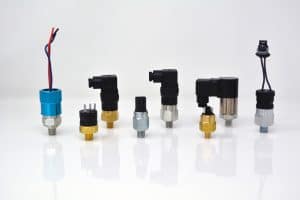
A pressure switch is a mechanical or electronic device that is activated when a certain threshold or setpoint is reached by the process fluid’s pressure. The pressure switch can differ depending on whether it consists of a bourdon tube, piston, diaphragm, or membrane that moves or deforms depending on the degree of pressure applied by the system. For example, an air pressure switch is used to maintain a constant pressure and can turn the compressor off once the tank reaches the required air pressure level. If the air pressure drops and more is required, the switch can also turn the compressor on.
Pressure switches should not be confused with pressure transducers. The latter converts pressure into an electrical output signal. Click here to learn more about pressure transducers.
A pressure switch consists of the following key components:
There are two main types of pressure switches: mechanical pressure switches and electronic pressure switches.
Simple and robust, these switches are commonly used for less complex tasks. Mechanical pressure switches are triggered using a spring and a piston to control the pressure at which they are activated. The spring is the force opposing the inlet pressure, and its tension is adjusted via a set screw or knob. In turn, the spring pretension is directly related to the pressure at which an electric contact occurs. In the event of a drop in pressure, the switch resets to its original state. The mechanical pressure switch is better suited to handling high voltages and amperages compared to an electronic pressure switch. You can use them to increase or decrease pressure through a contact change.
Electronic pressure switches contain a pressure transducer, typically a strain gauge, and additional electronics that convert signals into readable output. An electronic pressure switch offers many advantages over a mechanical pressure switch. Some of the advantages include greater accuracy, less contact wear, excellent long-term stability, simple operation, and the ability to perform thousands of switching cycles.
A pressure switch can be used in a wide range of domestic and commercial applications as listed below:
There are several selection criteria to take into consideration when selecting pressure switches. Some of the important criteria are listed below:
A pressure switch is a passive device since all it needs to function is the presence or absence of pressure. Diaphragm pressure compresses a calibrated spring. If the spring tension reaches or exceeds the set point, it will close the contacts in an NO switch or open them in an NC switch.
Anfield Sensors is one of the leading pressure sensor manufacturers, proving a wide range of pressure sensors to multiple applications. To know about the right pressure switch for your application, reach out to our technical experts today. You can also request a free sample by clicking the button below.
1. What is a pressure switch used for? – A pressure switch serves two main purposes. One is to regulate the pressure in the system or to ensure the reservoir level remains stable. Another is to safeguard equipment from damage or running at low efficiency.
2. What are the two types of pressure switches? – There are two main types of pressure switches: mechanical pressure switches and electronic pressure switches. Read this.
3. What is the difference between a pressure switch and a pressure transmitter? – Both pressure switches and pressure transmitters are used in pressure measurement applications, but pressure transmitters typically produce a continuous output, which is connected to a controller that monitors and responds to the pressure within a system. Pressure switches are simpler devices that don’t provide continuous outputs. Rather, it is a switch that can be toggled on and off, similar to a light switch.
4. Can I request a free pressure switch sample to test its application? – Yes. You can request a free sample by clicking here and filling out a form with your requirements. Click here to request a free sample.
Thank you for the information. One of our representatives will get in touch with you shortly.